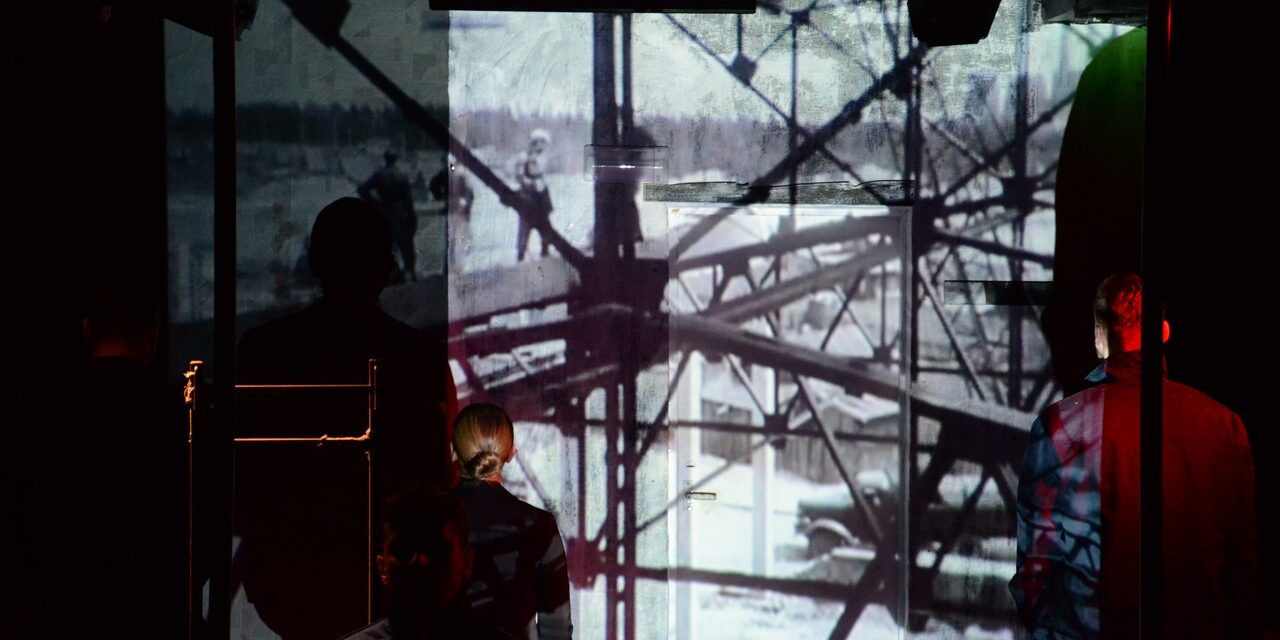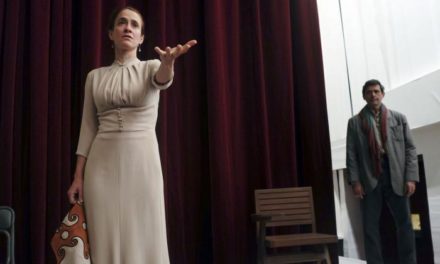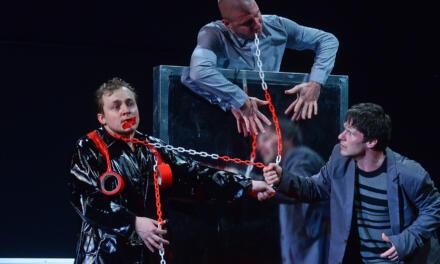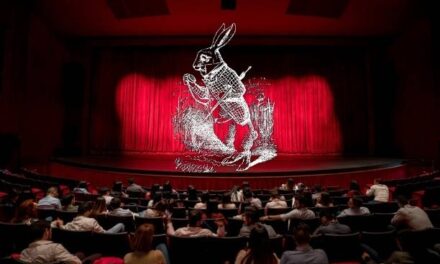Belarusian theatre is not well-known abroad because of a certain cultural isolation. Several local productions have been presented at international theatre festivals, but most of the Belarusian stage shows still happen under the radar (in terms of global theatre tendencies). As with many regional theatres, Belarusian theatre has its own peculiarities, and one of the most noticeable is a tendency towards the mediatization of dramatic readings.
It is clear that the staging process traditionally begins with a dramatic reading, which is necessary for the formation of a director’s personal vision of dramaturgy, as well as the actors’ ideas about the characters in the context of the play’s plot development. However, the role of the dramatic reading in Belarus tends to transform from the initial analysis of literary material into a variation of a show – the reading, which includes an organized mise-en-scene, elements of the set design and even stage directions.
This expanded reading format, which balances between stage show (in a traditional theatre meaning) and conceptual postmodern performance, has evolved because of the necessity to present both the play that is supposed to be staged and the producers’ intention to show how the performance will look with the aim of raising funds for a future staging. On the other hand, there is a need for small drama festivals to demonstrate foreign, avant-garde, or unprofitable in a current theatre market conjuncture without actual staging.
It’s no surprise that contemporary global theatre includes “readings” as a common form of theatrical minimalistic performance. In their theoretical approach such dramatic readings fall under the definition of Jerzy Grotowski’s “Poor Theatre” aesthetics: usually they follow a non-commercial theatre format, which strips away most of the theatrical excesses (such as costumes, stage scenery, and even stage), and they are often performed only once, before a small audience.
Talking about contemporary Belarusian theatre, it is obvious that the number of expanded dramatic readings has grown over the years. This process in the Belarusian theatre first and foremost is caused by an objective lack of staging resources and funds required to stage a full-fledged performance. Another indirect contributing factor is the development of online crowdfunding platforms (with ulej.by being the most popular). It is easier to raise funds for a low-cost reading performance than to collect money for a “big” stage show. Dramatic readings can demonstrate the material’s potential – is it worth a future production, or not? And if the reading is successful enough, the production team may launch a campaign to raise funds for a “real deal” staging.
The next important thing to mention (which is also common in Belarusian theatre) is that a reading is the only possible way for a vast majority of playwrights to show their work to an audience. The same happens in the case of young stage directors for whom the reading format of a show is the only possible opportunity for them to present their own personal solutions independently from the main paradigm of the theatre’s repertoire policy.
For small theatre companies, there are several other benefits of expanded play readings which help them to develop their audience. First, the reading performance format can be held in conditions that are not suitable for a traditional theatrical production – as in the case of Grotowski’s “paratheatre” (literally “beyond theatre”). For example, the reading of the play Shame, by Alexey Makeychik, was set in the inner courtyard of the Republican Theater of Belarusian Drama, and the reading of the play Precinct, by Vit Korolev, was set on the stairs of the Ministry of Internal Affairs museum. It is also important that both of these readings had an elaborate mise-en-scène as well as a simple yet effective stage design, which brought these performances far closer to theatrical shows than to the old-fashioned understanding of the dramatic reading, while still not being full-fledged performances.
A second benefit, mentioned in passing above, is the opportunity to create a paradigm shift from established repertoire. This allows directors to try their hand at creative experiments, including bringing multimedia mediums and narratives to their shows as tools of artistic expression. The key source, in this case, is a screen projection. It’s obvious that the use of a screen onstage is a global theatrical trend. It might even be considered a trending tendency in Belarusian theatre nowadays. However, for most Belarusian stage shows, the use of screen projections is quite simplified and in some cases is redundant aesthetically. The most advanced example of screen projection use was first tested in expanded dramatic readings. Therefore, it is fair to argue that multimedia diversity on the Belarusian stage has become possible only because of the successful experience of screen-expanded dramatic readings over the past decade.
In this case, the reading format of the stage show has served the role of experimental laboratory for the use of multimedia on a Belarusian stage. First, the reading format has provided strictly economic benefits because the screen and the preparation of video materials (static visuals, videos, animation, and even real-time broadcasting) are far cheaper and far more mobile than most traditional stage-design decorations. Second, the use of visual technologies in such post-cinematic dramatic readings is quite often motivated by the directorial reading of the meta-text of the play and is aimed at attracting and enhancing viewers’ attention. Thus the play readings can demonstrate the reaction of the audience to specific ways of using screens or other multimedia in a show.
The reading as a “laboratory” for a search for tools of directorial expression based on understanding the playwright’s storytelling intentions can be illustrated by the reading of the play I Do Not Need Sex, by the playwright Lyoha Chykanas (performed at the Brest theatre Prastora KH and at Bobruisk’s “Time-Club / Anti-Cafe 13:87”). The projected static images allow the director of this dramatic reading to mark each of the three independent plotlines of the play, rendering the projections a kind of analog of nameplates (on which the scenes’ places of action places are written) from Elizabethan-era English theatre. Other multimedia approaches of this dramatic reading include the synthesized voice of Diman (explaining the character’s health condition and his way of communicating with everybody around him via computer) as well as projected images of real-time typing during the last scene, which shows the audience the tragic sarcasm of Diman’s attemps to type Anna’s name onscreen.
Localization of a play’s action by changing the projection background was also used by Natalia-Rosalia Rodina (the director at the Republican Theater of Belarusian Drama) during a dramatic reading of the play A Song Of The Immigrant. In a dramatic reading of Svetlana Lapteva’s play Where The Train Goes, Natalia-Rosalia Rodina used a GoPro video camera to broadcast a picture via projection onto the background of the stage. This visual solution (the communication of the actor with a visual projection) made it far easier to express the playwright’s initial idea of the communication and interaction of the main character with the other imaginary characters.
The meaning of this work is the hieroglyphic aesthetics of the moving image onstage. The projection was not just a decorative background but a self-explanatory, informational component that replaced the verbal information with a moving visual image, an attempt at an iconographic reinterpretation of the dramatic text.
Although this visual solution does not seem revolutionary compared with European, North American or Asia-Pacific theatre, it had a great influence on the post-cinematic theatrical productions which followed this dramatic reading. And the major discovery for the theatre companies was the fact that the audience was already prepared for this kind of aesthetics. So when this live-broadcasting approach was intended to be used in the show From The Secondary School (shown in Minsk’s OK16 culture hub), the production team knew how the local audience would react to this stage-design solution.
The presence of visual experiments within expanded readings allows making forecasts for the multimedia set-design development in Belarus, despite the fact that Belarusian theatre is very conservative and quite rejects most theatrical multimedia technologies. That’s why the tendency towards mediatization of dramatic readings is important for Belarusian theatre. So it is no surprise that almost every second dramatic reading show held by theatres and theatre companies implements screen projections and the use of sound design (including attempts at live sound processing). Of the latter striking examples of mediatized readings, I can name the most discussed reading of early 2019 – Steam, by the playwright Paul Pavlut. Steam used screen images throughout the show, and it had quite a diverse (for a reading format) sound-design solution.
Is the expanded reading format the only multimedia form of theatre in Belarus? No. Intermediality is present on the Belarusian stage. However, the implantation of video-projections, sound design, and multimedia stage technologies is not so fast and effective as within the global theatre tendencies. That’s why expanded dramatic readings, which utilize a synthesis of cinema and theatre aesthetics, are of particular interest. Especially because most current “stationary” intermedial stage productions are completely “raw” and unfinished in terms of artistic quality.
It is the screen aesthetics experiments within the expanded reading format that serve a tutorial role. No doubt the formal presence of the screen in a stage production (and especially in the dramatic reading format) does not make such shows a part of intermedial theatre. The thoughtless combination of a screen and live action does not make a stage show a cinematic work, but it definitely may reduce the staging to a set of actors’ sketches in front of the projection screen.
So there is two-edged problem in terms of multimedia and post-cinematic theatre productions in Belarus. On the one hand, there is a need for visually expressive means onstage that will help to engage the audience. On the other hand, there are no Belarusian educational programs or training courses about how to use the multimedia means onstage. And the only way to explore these means is to learn how they are used in foreign productions, which might be seen on the web or during festivals, while the only way to try them before a full-fledged performance is to make a mediatized expanded dramatic reading performance.
Another related question is about the amount of reading mediatizations: are they a leading form of dramatic reading format? It may vary. During one year there was a dozen of media-expanded dramatic readings; during another there were just a couple of expanded readings.
For sure, it is absolutely wrong to set dramatic readings against full-fledged stage productions, since the reading format implies further staging work. But because of the artistic incompleteness of the dramatic reading, it creates conditions for the further development of artistic experiments onstage. A reading is sometimes used as an alternative to a full-fledged stage play for financial reasons. Because it is very cost-effective, it might be done in an unusual stage environment that is not suitable for a traditional stage production; it is meant to be performed before a small audience, it forgives the absence of costumes and stage scenery, and the actors may spend less time on rehearsals (as a result they don’t have to learn their text by heart, since the word “reading” suggests that actors will be reading the text from the page).
Summarizing this review, reading is not the most promising phenomenon of Belarusian theatre. It is hard to forecast with 100 percent accuracy the further development of dramatic readings, since the theatre is not standing still and is actively developing all the time. But according to current Belarusian theatre trends, readings are preserving the character of the primary tool for experiments with performance aesthetics both visually and thematically. The main peculiarity of local dramatic readings is the combination of the typical Grotowski “Poor Theatre” toolkit with the search for means of immersive multimedia expression.
This post was written by the author in their personal capacity.The opinions expressed in this article are the author’s own and do not reflect the view of The Theatre Times, their staff or collaborators.
This post was written by Alexander Mantush.
The views expressed here belong to the author and do not necessarily reflect our views and opinions.


















